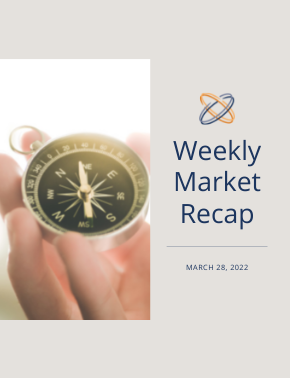Week in Review
Equity Markets:
For the second week in a row, major indices were positive. The S&P and NASDAQ ended the week up approximately 2%. The NASDAQ continued its strength from last week after being the worst performing major index for the year. The NASDAQ has cut its year-to-date losses in half, and is now down 9.7% for the year. The S&P is now down 4.7% for the year and has recouped the majority of the losses since the start of the war in Ukraine.
The next earnings season begins in a few weeks, and a recent theme from companies is that they are lowering their expectations. According to FactSet, 66 out of the 95 companies that have changed guidance have lowered their expectations for earnings.
Fixed Income Markets:
Yields grabbed the majority of headlines this week. The 10-year treasury ended the week at 2.48% after seeing an intraday high of more than 2.5%. The middle part of the yield curve has inverted. The 3-year to 7-year treasuries currently have a higher yield than the 10-year. This is not a major surprise due to the Fed’s recent action.
It is important to note that this inversion is not the yield curve inversion market participants pay the closest attention to. Many watch the 2-year and 10-year inversion. The 2s/10s spread has narrowed throughout the year – it currently stands just above 20 basis points (0.20%).
Fed Chairman Jerome Powell reiterated the Fed’s commitment to battling inflation. Chairman Powell also stated that rate hikes will continue for as long as needed to get pricing pressures under control, and admitted the Fed’s underestimation of the length of this battle with inflation.
Economic:
Economic news for the week did not meet expectations. The final University of Michigan Consumer Sentiment Index was revised lower to 59.4. The revision was caused by both current and expected financial conditions.
The largest disappointment was the housing market. Pending home sales fell by approximately 4% month-over-month. Rising mortgage rates will likely continue to put pressure on the housing market.
Looking Ahead
Equity Markets:
As long-term investors, we try to focus primarily on corporate earnings. With recent downward earnings revisions, the S&P’s forward price-to-earnings ratio is approximately 19x. This is slightly above the 5-year average, but we do not consider this level grossly overvalued. From a risk-return tradeoff, the equity market still provides an attractive profile when compared to other investable markets. There are risks present, including rising rates and the war in Ukraine, but we believe that it is important to remember how resilient the equity markets have historically been when faced with challenges. The market continuously works to discount future expectations.
According to LPL research going back to 1962, nearly 80% of the time, the S&P has been positive during a rising rate environment. Geopolitical events have historically shown to be short-lived and, while the bottom may not yet be in, if history holds true, a swift recovery remains a possibility as long as a recession is taking hold. While recessionary risks have increased, we don’t believe a recession is currently probable. Heightened volatility and meaningful corrective market moves tend to be the norm in mid-term election years.
During times of market volatility, it is easy to lose sight of long-term investment goals, especially with the crosscurrents in play today. We believe this is why it is important to have a broadly diversified portfolio that can maneuver through times like the present. The components of a well-diversified portfolio rarely move in unison. Investors must remember that the winners of last year may not be the winners of today.
Fixed Income Markets:
The 10-year treasury has reached the lower bounds of the range which we anticipate it will cycle for the next 12-18 months. Volatility should be expected as rates settle into a range unseen in almost three years. The yield curve will be a major focus. An inversion of the 2-year to 10-year treasury has historically been a reliable recessionary indicator. With the current spread, it is not an immediate concern, but we believe it is something that warrants continued attention.
Economic:
The week will start off with the Consumer Confidence Report and JOLTS. We will see important updates at the end of the week on the strength of the economy with personal income and spending, and the ISM Manufacturing Index.
Important Disclosures:
Investment Advisory Services offered through Krilogy®, an SEC Registered Investment Advisor. Please review all prospectuses and Krilogy’s Form ADV 2A carefully prior to investing. This is neither an offer to sell nor a solicitation of an offer to buy the securities described herein. An offering is made only by a prospectus to individuals who meet minimum suitability requirements.
All expressions of opinion are subject to change. This information is distributed for educational purposes only, and it is not to be construed as an offer, solicitation, recommendation, or endorsement of any particular security, products, or services.
Diversification does not eliminate the risk of market loss. Investments involve risk and unless otherwise stated, are not guaranteed. Investors should understand the risks involved of owning investments, including interest rate risk, credit risk and market risk. Investment risks include loss of principal and fluctuating value. There is no guarantee an investing strategy will be successful. Past performance is not a guarantee of future results. Indices are not available for direct investment; therefore, their performance does not reflect the expenses associated with the management of an actual portfolio. The S&P data is provided by Standard & Poor’s Index Services Group.
Services and products offered through Krilogy® are not insured and may lose value. Be sure to first consult with a qualified financial advisor and/or tax professional before implementing any strategy discussed herein.














